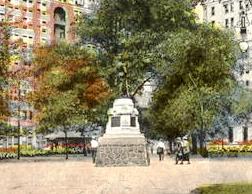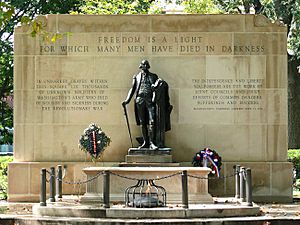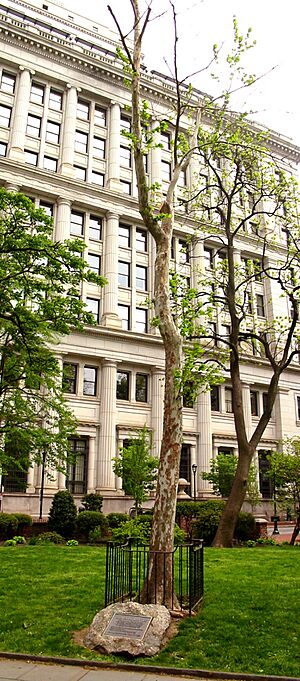Washington Square (Philadelphia) facts for kids
Quick facts for kids |
|
|
Washington Square
|
|

Washington Square in 2018
|
|
| Lua error in Module:Location_map at line 420: attempt to index field 'wikibase' (a nil value). | |
| Location | between Walnut and 6th Sts., West and South Washington Square Philadelphia, Pennsylvania |
|---|---|
| Area | 6.4 acres (2.6 ha) |
| Built | 1683 |
| Architect | Thomas Holme G. Edwin Brumbaugh |
| MPS | Four Public Squares of Philadelphia TR |
| NRHP reference No. | 81000558 |
| Added to NRHP | September 14, 1981 |
Washington Square is a 6.4 acres (2.6 ha) park in Center City, Philadelphia. It was first created in 1682 and was known as Southeast Square. This park is one of five original squares planned by William Penn's surveyor, Thomas Holme.
Today, Washington Square is part of the Washington Square West and Society Hill areas. In 2005, the National Park Service took over managing the park. It is now a part of Independence National Historical Park.
Contents
History of Washington Square
In the 1700s, this area was not a fancy park. People used it to let animals graze. It was also a burial ground for the city's African Americans. It served as a "potter's field," a place where people who couldn't afford a private burial were laid to rest.
During the American Revolutionary War, many soldiers from the Colonial army were buried here. After the war, victims of the yellow fever outbreaks in the city were also buried in the square.

Improvements to the park began around 1815. The neighborhoods nearby were growing and becoming popular. In 1825, the park was officially named Washington Square. This was done to honor George Washington. People even suggested building a monument to him here. While that specific monument was never built, it led to the idea of honoring Revolutionary War soldiers.
Washington Square was also a center for publishing companies. Many important book publishers were located here. One company, George T. Bisel Co., has been there since 1876. It is still owned by the Bisel family today.
A cool historical fact: Washington Square was the site of the first human flight in the Americas! In 1793, Jean-Pierre Blanchard launched his hot-air balloon from the nearby Walnut Street Prison.
Civil War Monuments
At first, Washington Square had monuments honoring those who fought in the American Civil War. One of these was the Washington Grays Monument. However, in 1954, a decision was made to change the park's focus. All Civil War memorials were moved. The square then became dedicated only to the memory of the Revolutionary War.
Tomb of the Unknown Revolutionary War Soldier
In 1954, planners decided to build a monument to all soldiers and sailors of the Revolutionary War. This was instead of the original idea for a monument just to George Washington. This special monument is called the "Tomb of the Unknown Revolutionary War Soldier."
The monument was designed by G. Edwin Brumbaugh. It features a bronze statue of Washington by Jean-Antoine Houdon. The Tomb holds the remains of a soldier found within the park. It is not known if the soldier was Colonial or British. Many other bodies are still buried under the square and the surrounding area. Sometimes, more are found during construction work.
The Moon Tree
There was a special sycamore tree in the square called a "moon tree." It was planted in 1975. This tree grew from seeds that traveled to the moon with astronaut Stuart Roosa on the Apollo 14 mission.
The original moon tree died in 2009. A new clone of the tree was planted in 2011. However, this replacement tree also died by November 2019. Only the plaque remains to tell its story.



